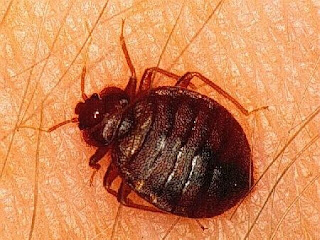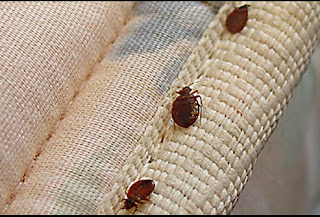Your bed bug exterminator should get involved in this process. Exterminators have chemicals that kill any bed bugs hiding on your mattress, box spring, headboard and frame. So, depending on what your pest control tech tells you, some of these steps may not be necessary for you to do on your own. Again, clear the following plan with the expert before you begin.
- Zippered dust-mite encasements for your mattress, box spring and pillows. These are basically large
- bags that are designed to keep dust mites inside the encasement - but they also keep bed bugs inside. Find them at allergy supply stores.
- Wide duct tape.
- Contractor grade trash bags (not lawn and leaf bags, but the thick contractor grade trash bags, at least two or three mils thick).
- Wide double-sided tape.
- Bed lifts to raise your bed off the ground (these are little stands that you set the legs of your bed frame into to raise it off the ground). Find them at your local bedding/linen store. Note that if your frame is already fairly high off the ground (like a foot or more), you don't need the risers.
- Four metal bowls large enough to place the bed lifts in (heavy duty plastic bowls are fine, too. Either way, they have to be unbreakable). Pet stores have nice metal bowls that are ideal for this.
- XXL Ziploc bags
- Food-grade freshwater diatomaceous earth. Also known as DE, diatomaceous earth is an abrasive mineral powder that kills bed bugs and other crawling insects by scratching open their skins, which dehydrates them (they die after a day or two). This stuff is razor wire for bed bugs - they will be able to crawl through it, but the damage they suffer is deadly. You can get DE everywhere: online, your local garden center (gardeners use it to kill pests, sometimes marketed as ant killer), or pet supply stores (food grade stuff is sprinkled on pets to kill fleas). Make sure you don't get swimming pool grade diatomaceous earth - that is the wrong stuff. Also, get a dust mask while you are at Home Depot - you'll wear it as you are dusting around your bed. A note about DE: While considered generally safe, you need to carefully read the label and follow all safety instructions. Wear a dust mask or respirator when applying.
- Murphy's Oil Soap. Murphy's is a wood cleaner made by Colgate-Palmolive that also has pesticide properties. You can find it everywhere. Buy the spray bottle.
- A new set of white sheets, pillowcases and covers. You are going to replace your existing bedding with new white linens, to better spot any fresh bed bug fecal spots or blood.
- New pillows: Your current ones might be infested, so let's start over with new ones.
- Optional: Something that kills bed bugs on contact. Rubbing alcohol in a spray bottle will do it. You can dilute the alcohol with a bit of water to make it last longer - 9 parts alcohol, 1 part water.
What to Do
Step 1: Clean your Linens and Bedding
First you need to pull all the bedding off your bed - sheets, mattress cover, comforter, pillows and pillow cases. Everything. These are infested with bed bugs, so you need to immediately stuff them into the trash bags and tie the bags off.
Now wash every item in hot water. Don't let those infested linens touch other linens or clothing items. Then dry them on high (at least 140 degrees) for 4 hours, or two complete drying cycles. When done, put each item into an XXL Ziploc and seal it.
Put your pillows in a contractor bag, seal it, and throw it in the trash. Cleaning a pillow thoroughly is tough, so you're better off starting with a new one.
Step 2: Vacuum Your Mattress and Box Spring
You are now going to clean the mattress and box spring of any bed bugs, eggs, or larvae.
Get out you vacuum cleaner and clean EVERY INCH of your mattress. Scraping the end of the vacuum attachment vigorously over the harborage area is better than using a brush, because the bugs cling tightly to the surface, and the eggs are cemented to it. Clean every inch of the surface, the tufts along the edges, and the sides of the mattress. Lean it against the wall and vacuum the other side.
Clean the box spring just as carefully. Tear that flimsy dust cover fabric off the bottom, seal it in a plastic bag and throw it away. Vacuum the insides, making sure to get every bit of fabric, as well as the wooden frames and support.
When you are done vacuuming, remove the bag from the vacuum, seal it in a plastic garbage bag, and throw it out. The vacuum bag will have bed bugs in it, and you don't want them to crawl out.
Step 3: Clean the Bed Frame
If you have a metal frame, you are in luck, because these are fairly easy to clean. Grab the vacuum and clean all the nooks and crannies. Pay special attention to inside corners, joints, the areas where the wheels attach to the frame - any dark little corners where bed bugs might hide.
Spray it down with rubbing alcohol to kill anything you missed. Use caulk or duct tape to fill in any holes or gaps between the metal pieces (bed bugs hide in the holes and joints).
If there are any hollow areas in your bed frame (sometimes, the legs are hollow), those are perfect places for the bed bugs to hide. Spray the interior with alcohol and vacuum them out.
If you have a headboard, you should get rid of it. The headboard is one of the most likely places the bugs will hide and lay eggs, and if you have one, I can pretty much guarantee you that it has bed bugs hiding on it. Put it in a plastic bag, carry it to the dumpster, spray paint the words BED BUGS on the package, and throw it in. (It is important to wrap the headboard in plastic before it leaves your bedroom. You don't want any bugs jumping off in the hallway on the way to the door.)
If you have a wooden bedframe, you need to disassemble it, and wash it down with Murphy's Oil Soap. Once you have the frame disassembled, vacuum it like you did with your mattress and box spring. You may need to use a stiff brush to dislodge any eggs or bed bugs in the nooks and crannies. Now spray the Murphy's onto the frame, making sure to spray it into every cracks and crevice.
Step 4: Clean and Prepare the Floor Around Your Bed
When you reassemble the bed, you have to position it away from the walls and furniture, so bed bugs don't have anything to use as a bridge to reinfest your bed. Usually, the best place is to position the bed toward the center of the room and the night stand or tables away from it.
Carefully vacuum the floor in the area under the bed. If you have any carpets or rugs, I think you should roll them up, put them in the trash bag, seal the bag tightly and put it in the garage or storage for the next 18 months. But consult with your bed bug exterminator. Rugs can be treated by with chemicals, so it's your call as to what to do.
Sprinkle the floor you just cleaned with a light dusting of DE. Don't make piles, just use a baby powder bottle or some other plastic bottle that can puff out a very light layer of the stuff.
Warning: DE is almost lighter than air, and it takes some practice to get used to. As with any pest control product, READ THE LABEL AND FOLLOW ALL SAFETY PRECAUTIONS. Wear a dust mask or respirator when applying.
Step 5: Reassemble the Bed Frame
Now reassemble your bed frame and move it to the middle of the room, over your dust field. Put the legs of the bed frame on the lifters, and put the lifters in the bowls. In other words, the bowl is on the floor, the lifter is in the bowl, and the bed frame is on the lifter.
Wrap plastic wrap around the legs of your bed (regular Saran Wrap is fine for this), then wrap double sided tape over the plastic wrap to catch any bed bugs crawling up.
For additional protection, spread Vaseline on the legs above and below the double sided tape. This is an old trick from the turn of the century, and another obstacle to gum up any bed bugs trying to crawl into your bed.
Put the encasement over the box spring. Put the box spring on the frame. Make sure you don't tear the encasement! Cover the zippered seam of the case with duct tape. Use a lot of tape, and extend it four to six inches from the end of the zipper. You are taping up the zipper because baby bed bugs are tiny, and can slip through the teeth of the zipper.
Gently put the mattress on the box spring. Gently pull the casing over it, and tape the zippers shut.
Now it is time to fill the bowls with soapy water. Bed bugs cannot traverse soapy water, so this becomes like a little moat, protecting the legs of your bed.
Put your new white sheets on the bed, over the encasements. With new sheets, you'll be able to see any blood spots, fecal stains, or crushed bed bugs that might have penetrated your defenses.
Step 6: Securing the Perimeter
Put down a three or four inch wide circle of double-sided carpet tape on the floor around your entire bed (be sure that you vacuumed within this area. If you didn't, do it now). This way, any bed bugs crawling from outside of your fortress will get caught in the tape.
And finally, be sure you have a dusting of DE extending 12 inches around the soapy water-filled bowls. You want to be sure that any bugs that try to get up those bowls have to go through the DE first. Again, this should only be a dusting of DE. You should not see much whiteness at all - thinner is better. Any more than that, and it won't work.
And you're done! Feels good to be taking the offensive, doesn't it? If everything works as planned, you've cleared the bed bugs off your bed, any that you missed are encased inside the mite cover, and the bed bugs elsewhere in the room will be unable to get into your bed. Finally, a chance to sleep!































